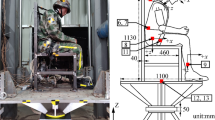Abstrac
In this paper, a method of modeling a seat belt on a crew seat during a dynamic seat testing was studied. The body segments of the occupant were modeled with joints that consisted of various stiffness, damping, and friction. Three types of seat belt restraint systems were investigated and an analysis on the injury assessment of the helicopter’s crew under a drop impact was conducted. The effectiveness of the seat belt system for crashworthiness and safety was likewise evaluated. From the impact analysis results, it was determined that the head, neck, and spine of the crew body can be easily damaged in the vertical direction more than the longitudinal direction. Based on the verified model, the human body’s behavior was studied using three point restraint systems. The displacement and injury level of the 12-point restraint system was the smallest.
Similar content being viewed by others
References
Department of defense joint service specification guide, Crew systems crash protection handbook, JSSG-2010-7, (1998).
J. H. Lee, Y. S. Lee and K. H. Han, A study on impact analysis of side kick in taekwondo, International Journal of Modern Physics (B), 22(9–11) (2008) 1760–1765.
J. H. Lee, Y. S. Lee, K. H. Han, H. S. Lee and E. Y. Lee, A study on the dynamic analysis of side kick in taekwondo, Transactions of the KSME (A), 32(1) (2008) 83–90.
MIL-S-58095(AV), Seat system, crashworthy, nonejection, aircrew, Military specification, (1971).
R. F. Chandler, Occupant crash protection in military air transport, AGARD-AG-306, (1990) 75–89.
Author information
Authors and Affiliations
Corresponding author
Additional information
Young-Shin Lee received a B.S. degree in Mechanical Engi-neering from Younsei University, Korea in 1972. He received master and Ph.D. degree in Mechanical Engineering from Yonsei University, Korea in 1974 and 1980 respectively. He is currently professor and Dean of Industry Graduate School and Director of BK21 Mechatronics Group at Chungnam National University, Korea. Prof. Lee’s research interests are in area of impact mechanics, optimal design, biomechanical analysis and shell structure analysis.
Jung-Hyun Lee received a B.S. degree in Mechanical Design Engineering from Chungnam Na-tional University, Korea in 2007. He received master degree in Mechanical Design Engineering from Chungnam National Uni-versity, Korea in 2009. He is currently researcher of Korea Aerospace Research Institute, Korea.
Kyu-Hyun Han received a B.S. degree in Mechanical Design Engineering from Hanbat National University, Korea in 2002. He received master degree in Mechanical Design Engineering from Chungnam National University, Korea in 2004. He is currently researcher of Simuline Inc, Korea.
Rights and permissions
About this article
Cite this article
Lee, YS., Lee, JH., Han, KH. et al. A study on the modeling and analysis of a helicopter’s occupant seat belt for crashworthiness. J Mech Sci Technol 23, 1027–1030 (2009). https://doi.org/10.1007/s12206-009-0334-3
Received:
Revised:
Accepted:
Published:
Issue Date:
DOI: https://doi.org/10.1007/s12206-009-0334-3




